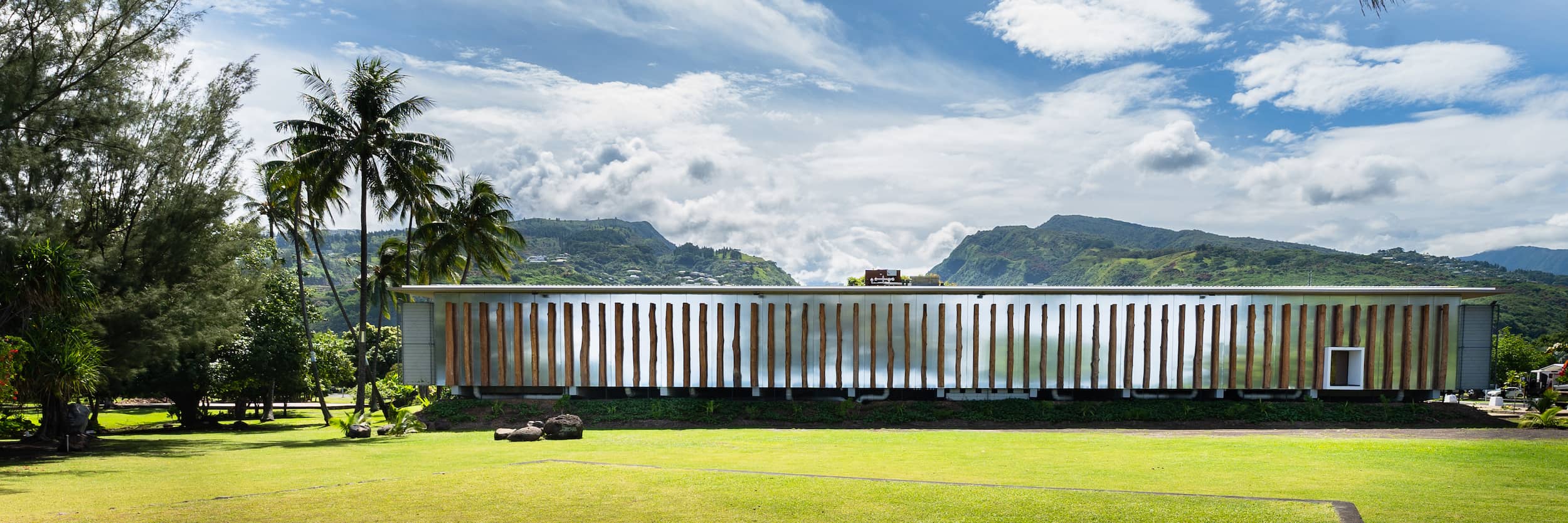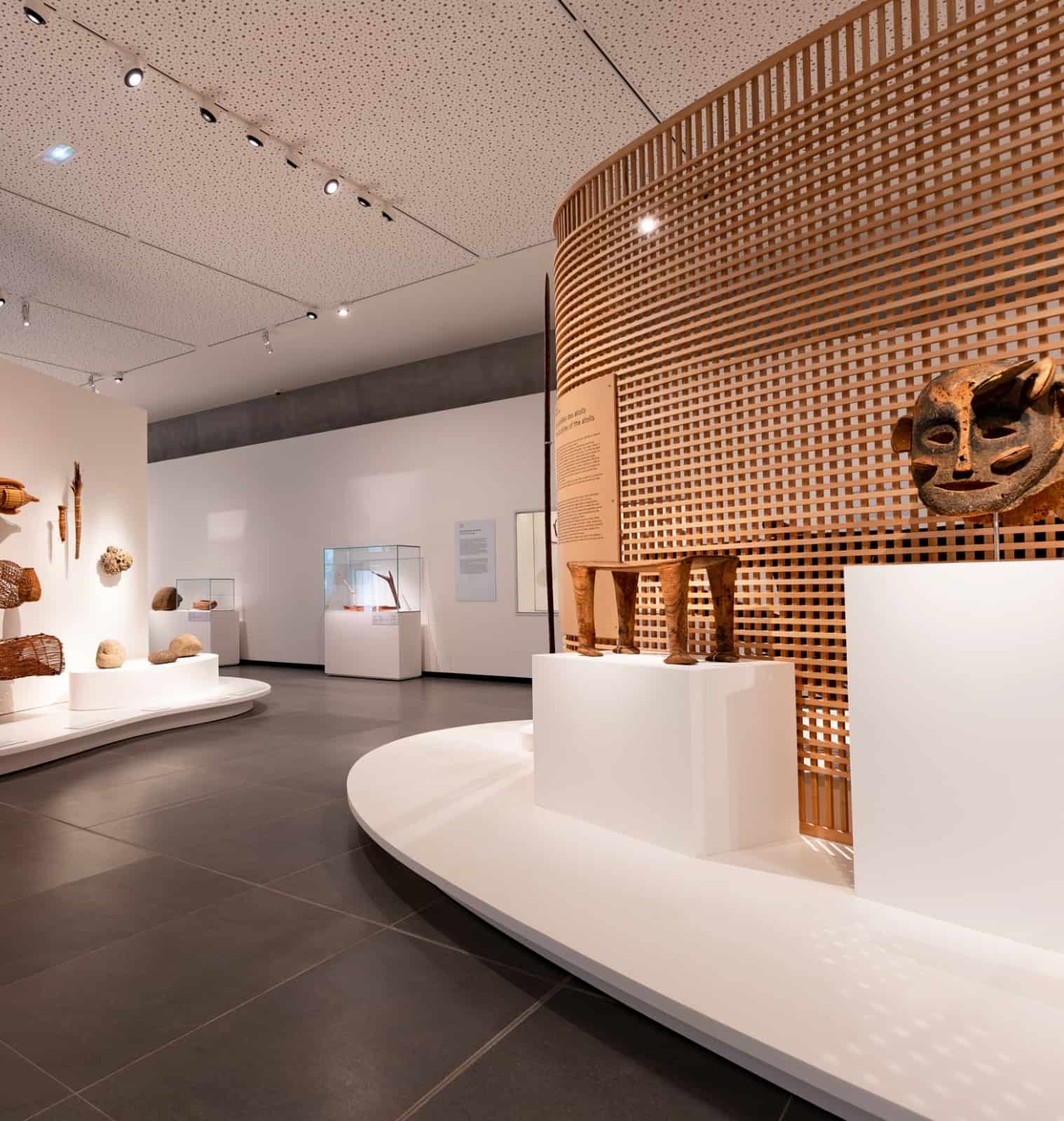
THE MUSEUM
INTRODUCTION
Te Fare Iamanaha
Located in Puna’auia, on Hiti land, Nuuroa point, Te Fare Iamanaha offers visitors the keys to a reflection on the common cultural heritage of the Polynesians of which it is guardian, while emphasizing the singularities and particularities of each archipelago.
Beyond the exhibition of collections, the dimension of the transmission of knowledge and related concepts is essential. The museum is part of a dynamic vision and a contemporary approach to Polynesian culture in line with the current aspirations of the population.
The establishment thus has a new, completely rebuilt exhibition hall, a temporary exhibition hall, a conference room, a park and an ethnobotanical garden.
>The museum’s collections consist mainly of ethnographic objects, mostly from French Polynesia, as well as other regions of Oceania. Te Fare Iamanaha also keeps fine arts collections, a photographic and archival fund, movable objects, but also natural collections. Finally, the museum also houses the herbarium of French Polynesia, whose database is accessible online: https://nadeaud.ilm.pf
STORY
At P.K. 15 in the town of Punaauia, ‘ôutu Nu’uroa houses the Museum of Tahiti and the Islands ‘ Te Fare Manaha located between the mouth of the Punaru’u and the Punaauia point called Burder’s point by the missionaries and now called Pointe des Pêcheurs.
Nu’uroa Cape has always been a prestigious place in the history of Tâhiti because it is located on the lands of the Atâhuru chiefdom under the tutelage of the Te’oropa’a clan, which once included Temanotahi and Temanorua namely the current municipalities of Punaauia and Pa’ea. On this site was built the most important religious complex of Tâhiti from the origin until the arrival of the first discoverers from 1767.
In 1815, this cape witnessed the battle of Fê’ipi which saw the victory of Pômare II and also the end of the ancient religious cult, in particular that of the god ‘Oro.
In 1819, missionaries D. Darling and R. Bourne of the London Missionary Society came to settle in Burder’s Point to build a temple, a school and set up a printing press from which the first grammar of the language would come out. Tahitian in 1823.
From 1844 to 1846, Punaauia was the scene of military confrontations during the Franco-Tahitian war and its surrender. A large tower was built in Nu’uroa and two forts at the entrance to the Punaru’u valley.
Across from the Museum of Tahiti and the Islands ‘Te Fare Manaha, is the Sapinus surf ‘spot’ at the world famous.
HERITAGE
THE MISSIONS
The mission of the establishment is to collect, conserve, restore, reproduce and present to the public collections relating to the heritage of Oceania, and more particularly Polynesian.
It can organize events of a cultural nature or participate in the organization of these.
An organization for the promotion, study and dissemination of this heritage, the Museum has acquired over the years a role of expertise in the field of preservation of tangible and movable cultural property.
Today, it is the main institution in French Polynesia to offer the discovery of the treasures of Polynesian natural and cultural heritage in the same space.
Set in a three-hectare park located at Nu’uroa Point, in the town of Puna’auia, the Museum of Tahiti and the Islands also offers an ethnobotanical tour.
THE ORGANIZATION CHART
Hinanui Cauchois
Hinanui Cauchois has been the museum’s new director since December 1, 2023, succeeding Miriama Bono.
Originally from Mo’orea, Hinanui holds a PhD in archaeology from the University of Hawaii, obtained in 2015, and specializes in Polynesian and Society Island archaeology. She is also a graduate of the Université de Paris-I Panthéon-Sorbonne.
She has carried out numerous archaeological missions in French Polynesia, under the aegis of the Department of Culture and Heritage. A specialist in Polynesian cultural heritage, she wrote the book on weaving published by Éditions au vent des Îles in 2013.
Alongside archaeology, Hinanui has taught history-geography at secondary level in Tahiti and Ra’iātea, and the history of ancient Polynesian societies in higher education.
She has also contributed to the scientific updating of curriculum content on archaeology and ancient societies for secondary schools.
She has also served as technical advisor to two different ministries in 2008-2009 and 2023, in charge of archaeological heritage and more recently higher education. In this capacity, Hinanui helped launch the UNESCO World Heritage listing applications for the Taputapuātea marae in Rai’ātea and the Marquesas Islands in 2009.
Today, her mission is to help develop the institution for all and links with museums in the region and beyond.
Telephone: 40 54 84 43 direction@museetahiti.pf
Pôle Conservation
Tamara MARIC
CONSERVATRICE
conservateur@museetahiti.pf
40 54 84 40
Marine VALLÉE
ASSISTANTE CONSERVATRICE
conservation2@museetahiti.pf
40 54 84 45
Tara HIQUILY
Assistant conservateur
taraconservation@museetahiti.pf
40 54 84 38
Pôle ADMINISTRATION
Gwenola RIOUAL
ATTACHÉ ADMINISTRATIF
admin@museetahiti.pf
40 54 84 42
Pôle régie
Tama PEA
RÉGISSEUR/AIDE-COMPTABLE
regisseur@museetahiti.pf
40 54 84 37
PÔLE ACCUEIL/MEDIATION
Melissa DOOM
AGENT D’ACCUEIL/MEDIATEUR CULTUREL
mediation@museetahiti.pf
40 54 84 49

